Recent Storm Damage Posts
Are You Ready for Storm Damage?
10/12/2022 (Permalink)
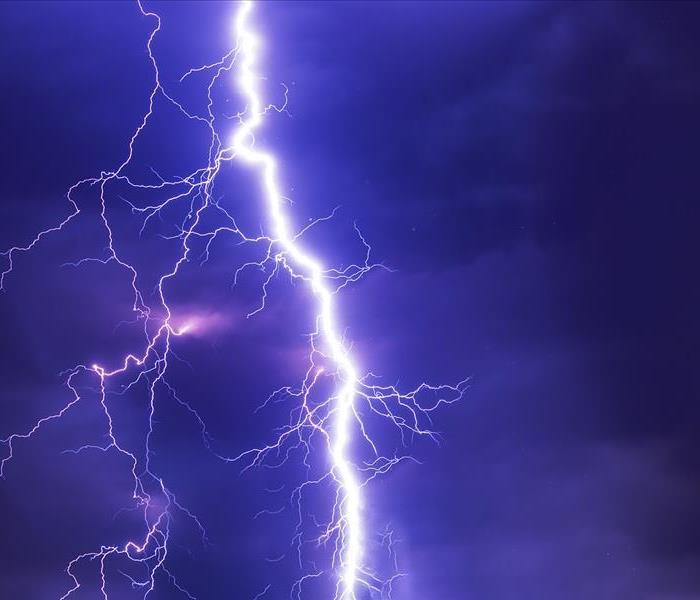 Storms can catch homeowners by surprise.
Storms can catch homeowners by surprise.
As anyone here knows, the weather in Southern & Central Jefferson County brings intense rain, wind, and ice storms. With weather that can switch quickly, it’s essential to ensure your home is storm-ready, prepared to handle and withstand unpredictable conditions.
It’s always a good idea to conduct a home and ground inspection before weather conditions worsen. Things like leaky roofs or windows can be very problematic in the midst of heavy rainfall and strong winds, so checking them and ensuring they are all fitted correctly is a critical step.
Checking for loose shutters and trimming back any trees or shrubbery that may be surrounding your home is another good way to get it storm-ready. Shutters, tree limbs, and other loose debris can get picked up by the wind and thrown in any direction, including toward your house. Also, inspect any drainage areas near or around your home, clearing them of debris-creating blockage. This will help reduce the chances of flooding your property during a storm.
Another thing to consider when preparing your home for a storm is what kind of system to have that will allow you to communicate with your loved ones and receive weather updates. In some cases, storms can become strong enough to put your cell phone’s service signal at risk, so it’s good to be prepared and have an alternative form of communication in place.
And as always, SERVPRO of Southern and Central Jefferson County is here to help in the event of storm damage. We’re available 24/7 and ready when you need us. Give us a call at (636) 467-5444.
Trees and Tornadoes
10/26/2021 (Permalink)
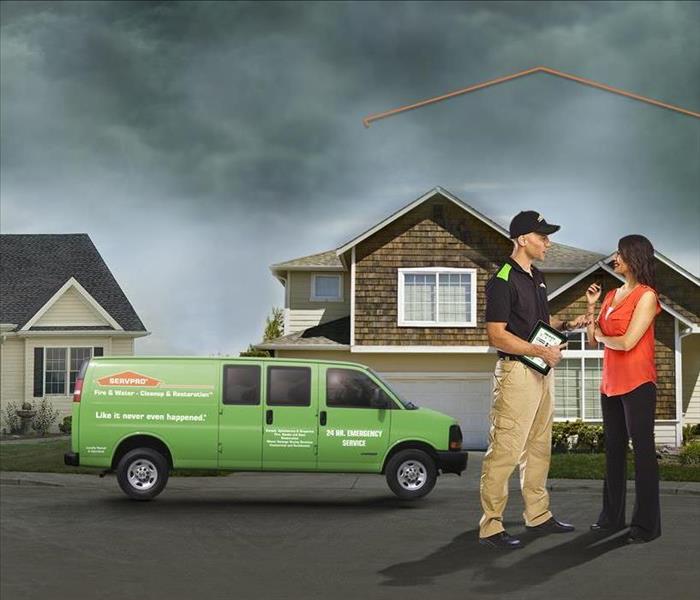 Storm damage? We can help you.
Storm damage? We can help you.
Tree Branches Become Debris in a Tornado
We love to have our tall leafy trees in our yards to keep our house cool during the summer heat. The shade they provide is wonderful when the sun is high in the sky.
These same trees we love can also be very harmful during a storm or tornado if they are not trimmed regularly. Strengthening the trees around your property can help keep their limbs from being torn off and becoming debris in a storm. Here is what to look for when trimming trees around your home:
- Limbs with wounds
- Decaying branches
- Structural defects
- Limbs rubbing against each other
- Exposed roots
If your trees are trimmed properly before the stormy season they will be less likely to become debris. Many homes can be destroyed by tornadoes in our servicing area if a tornado would arise. Learn more about the ways SERVPRO of Southern and Central Jefferson County can help during stormy weather. As always, you can call us anytime at 636-467-5444.
Storm Ready Kit
10/26/2021 (Permalink)
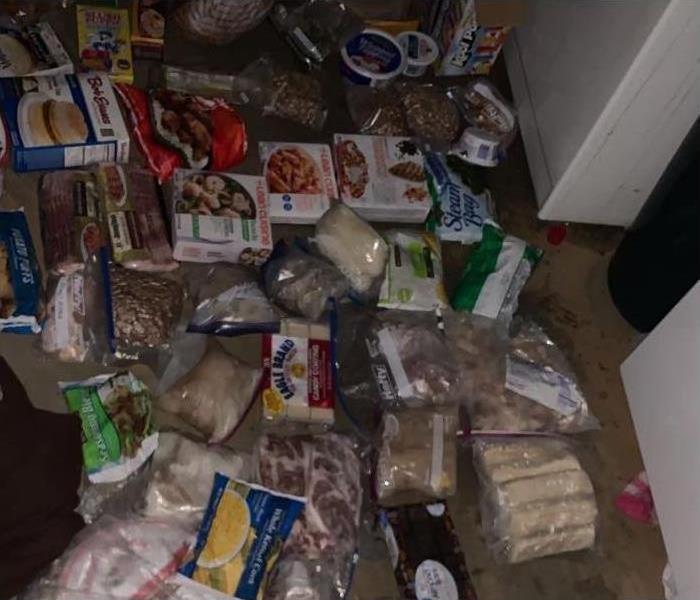 Always be prepared! Here' an idea of what a storm kit looks like.
Always be prepared! Here' an idea of what a storm kit looks like.
It feels as if we are constantly prepping for a storm - whether that is a tornado, thunderstorm, or even the rare winter storm that passes through the southeastern part of Missouri.
Our team at SERVPRO headquarters (HQ) has put together a list of basic household items you may want to keep in stock and store in a weather proof, safe place in case you find yourself in an emergency storm situation. We encourage checking on your items every 3 months to ensure they are in working order and haven't passed the expiration date.
Suggested items:
- Water- one gallon per person for at least three days.
- Food- at least a three day supply of non-perishable food.
- Battery powered or hand crank radio
- Flashlight.
- Extra batteries.
- Candles.
- Phone chargers.
- Road flares.
- Rain ponchos.
- Tarp.
- Wet wipes.
- A whistle to signal for help.
When you get caught in a storm, damage to your home is likely. It could be from a limb on your tree or rain leaking through a window. If you see any damage to your home due to a storm, call us at 636-467-5444 so we can help you through the mitigation process.
Storm Ready Kit
10/26/2021 (Permalink)
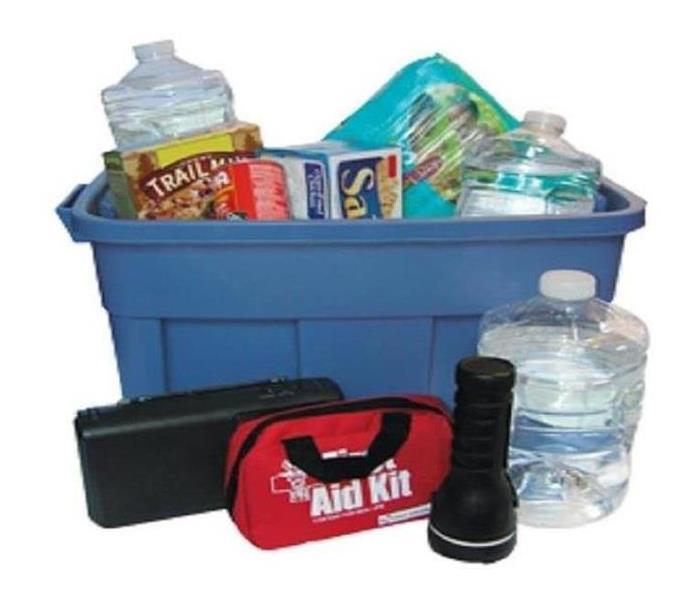 Always be prepared! Here' an idea of what a storm kit looks like.
Always be prepared! Here' an idea of what a storm kit looks like.
It feels as if we are constantly prepping for a storm - whether that is a tornado, thunderstorm, or even the rare winter storm that passes through the southeastern part of Missouri.
Our team at SERVPRO headquarters (HQ) has put together a list of basic household items you may want to keep in stock and store in a weather proof, safe place in case you find yourself in an emergency storm situation. We encourage checking on your items every 3 months to ensure they are in working order and haven't passed the expiration date.
Suggested items:
- Water- one gallon per person for at least three days.
- Food- at least a three day supply of non-perishable food.
- Battery powered or hand crank radio
- Flashlight.
- Extra batteries.
- Candles.
- Phone chargers.
- Road flares.
- Rain ponchos.
- Tarp.
- Wet wipes.
- A whistle to signal for help.
When you get caught in a storm, damage to your home is likely. It could be from a limb on your tree or rain leaking through a window. If you see any damage to your home due to a storm, call us at 636-467-5444 so we can help you through the mitigation process.
Solar Panels and Storms
8/16/2021 (Permalink)
You may be wondering what will happen to your solar panels during a major storm. After all, while your panels are durable, they are not indestructible.
In general, panels should be able to survive harsh weather conditions. However, panel damage can still occur during storms. Below are some common causes of harm to these panels.
Lighting
Lightning strikes can destroy your panels. Thankfully, there are products available that can protect the panels from electrical harm. For instance, you can install a surge protection device for the panels.
Fire
Lightning can also spark fires that cause solar panel or roof damage. It is not just the flames themselves that can harm your panels. Extreme heat alone may cause them to malfunction. Adding fans or another form of ventilation may help.
Snow
Of course, destructive storms do not just include lightning. They can also bring heavy rain or snow. Snow can build up on top of the panels. To prevent panel damage, this snow should be removed immediately.
Falling Debris
Storms may also cause large branches to strike your panels. While this debris might not break the panels, the falling objects may make your panels less efficient over time.
Still, solar panels are strong. If the anchor and racking can survive high winds, your panels should be secure during hurricanes and rainstorms. In fact, a 2017 hailstorm that pounded the Denver area only broke one solar panel at the National Renewable Energy Laboratory in nearby Golden. The lab has more than 3,000 panels on its campus. Researchers from the NREL have developed tests to ensure that various panels on the market can withstand harsh conditions.
Your panels should be able to withstand storms. Best of all, any solar panel damage that does occur may not be permanent! If we can assist you in any way, give us a call at 636-467-5444.
Tips for Keeping Your Home Dry During Heavy Rain
8/16/2021 (Permalink)
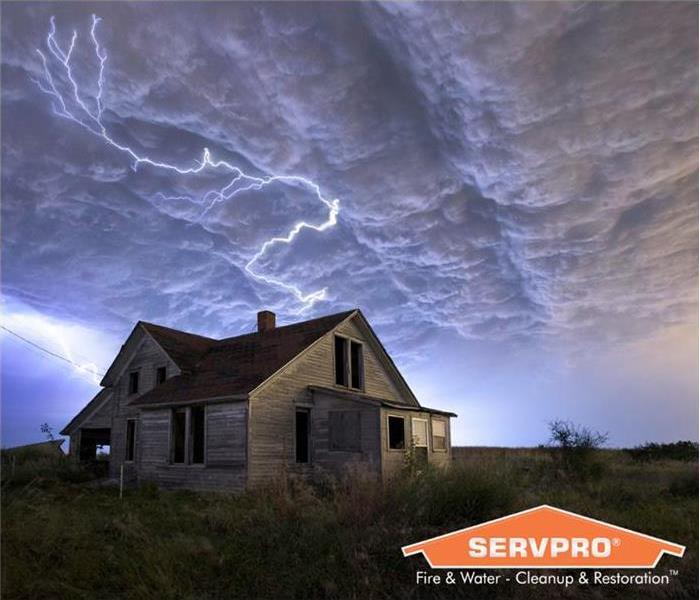 Need help with storm damage? Give us a call.
Need help with storm damage? Give us a call.
Water damage can happen to your home in a variety of ways. Many homeowners think that only severe storms and floods or a major appliance malfunction involving your washing machine or dishwasher cause water damage.
But heavy rains are a significant water damage threat, too. These drenching storms frequently happen in our area during the spring and summer months. If your home is not prepared, these storms can cause costly damage.
Water Damage Is Common
Millions of Americans file claims to repair home water damage every year. Insurance industry experts estimate that as many as one out of every 50 homeowners will file a water damage claim this year.
Depending on how many people live in your neighborhood, that can mean someone you know will have to deal with water damage this year.
Homeowners can’t always avoid water damage. For example, severe storms can cause significant damage to many homes in the community. And homeowners can’t avoid these natural disasters.
But sometimes more common problems, namely heavy rains, can cause water damage to your home. Homeowners can avoid this type of damage if they ensure your home is well-maintained.
Getting Ready for Wet Weather
Our teams are prepared to help homeowners repair water damage. We’re experts, and that means we see many of the issues that cause the damage in the first place.
Because we know how the damage happens, we’ve put together some ideas to help you avoid it:
Check your yard. Knowing how your yard drains is vital to protecting your home. If you notice that your yard is draining toward your home, then you might want to connect with a landscaping expert to look for ways to protect your yard.
Choose the right type of landscaping. Many people choose plants and flowers for aesthetic effect. But choosing landscaping items carefully can ensure your home is prepared for heavy rains. Native plants, trees and bushes can be vital in protecting your home from water damage. Talk with landscaping experts in the area or visit a native plant sale for tips and ideas.
Look into sealing your roof. Experts estimate that almost 95% of damage is caused by water finding its way through gaps in your shingles, which can be prevented with this step. It’s worth considering!
If you need help dealing with damage caused by water, fire or any other issue, we’re here to help you restore your home. We have crews who are available 24⁄7 in the event of an emergency. Contact us at any time to learn more about us and how we can help you restore your home to its original state. Call us at 636-467-5444.
Weather Facts
8/16/2021 (Permalink)
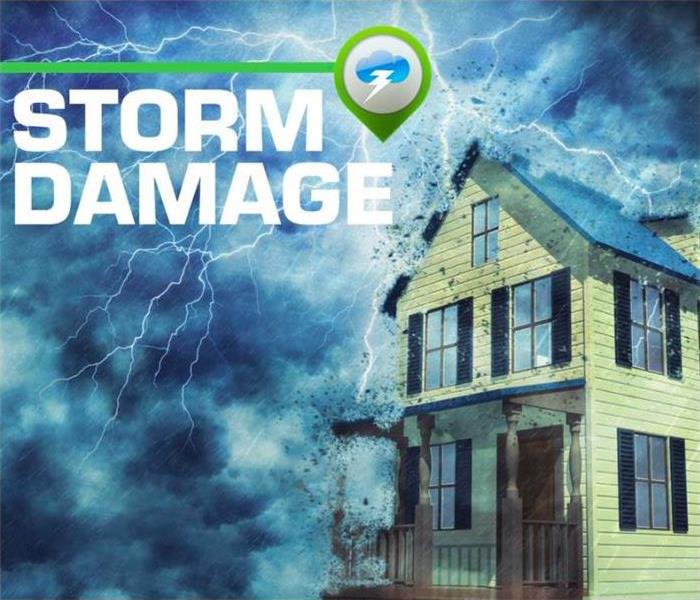 If you have any weather related damage, give us a call, anytime! 636-467-5444.
If you have any weather related damage, give us a call, anytime! 636-467-5444.
The highest temperature ever recorded in Antarctica is 14.6 °C (59 °F), recorded on January 5, 1974.
The most rainfall ever recorded in 24 hours is 182.5 centimeters (71.9 inches) in Foc-Foc, La Réunion, during tropical cyclone Denise on January 8, 1966.
The most rainfall ever recorded in one year is 25.4 meters (1000 inches) in Cherrapunji, India.
The highest snowfall ever recorded in a one year period was 31.1 meters (1224 inches) in Mount Rainier, Washington State, United States, between February 19, 1971 and February 18, 1972.
The fastest wind speed ever recorded is 484±32 km/h (301±20 mph). This was a 3 second gust recorded by a Doppler on Wheels (DOW) radar unit in Oklahoma City on May 3, 1999.
The heaviest hailstone ever recorded weighed 1.0 kg (2.25 lb) and landed in Gopalganj District, Bangladesh on April 14, 1986.
Clouds can be categorized into a number of different types; these include cumulus, stratus and cirrus.
The Earth experiences millions of lightning storms every year, they are incredible discharges of electricity from the atmosphere that can reach temperatures close to 54,000 °F (30,000 °C) and speeds of 60,000 m/s (130,000 mph).
The USA has more tornadoes than any other country in the world, averaging around 1200 a year. This is due largely to its unique geography which forms an area in central USA called “Tornado Alley” which is frequently hit by tornadoes.
Tropical cyclones (often referred to as hurricanes or typhoons) feature strong winds, driving rain, rough seas and areas of low atmospheric pressure. They frequently form in tropical areas of the globe and can do considerable damage to populated areas. Examples of this include the 1970 Bhola cyclone, Typhoon Nina which hit China in 1975 and more recently in 2005 when Hurricane Katrina which caused great devastation and loss of life when it hit southern parts of the USA.
http://www.sciencekids.co.nz/sciencefacts/weather.html
Storm Damage in Jefferson County, Missouri
7/14/2021 (Permalink)
 Storm Damage? Call us!
Storm Damage? Call us!
SERVPRO of Southern and Central Jefferson County specializes in storm and flood damage restoration. Our crews are highly trained and we use specialized equipment to restore your property to its pre-storm condition.
Faster Response
Since we are locally owned and operated, we can respond quicker with the right resources, which is extremely important. A fast response lessens the damage, limits further damage, and reduces the restoration cost. While we are physically located in Farmington, MO we provide service to a large portion of southeastern Missouri, officially servicing Jefferson County and surrounding counties.
Resources to Handle Floods and Storms
When storms hit our communities, we can scale our resources to handle a large storm or flooding disaster. We can access equipment and personnel from a network of 1,650 Franchises across the country and elite Disaster Recovery Teams that are strategically located throughout the United States. There is no loss too large for our teams.
Have Storm or Flood Damage? Call Us Today – 636-467-5444
Our Storm Damage
10/14/2020 (Permalink)
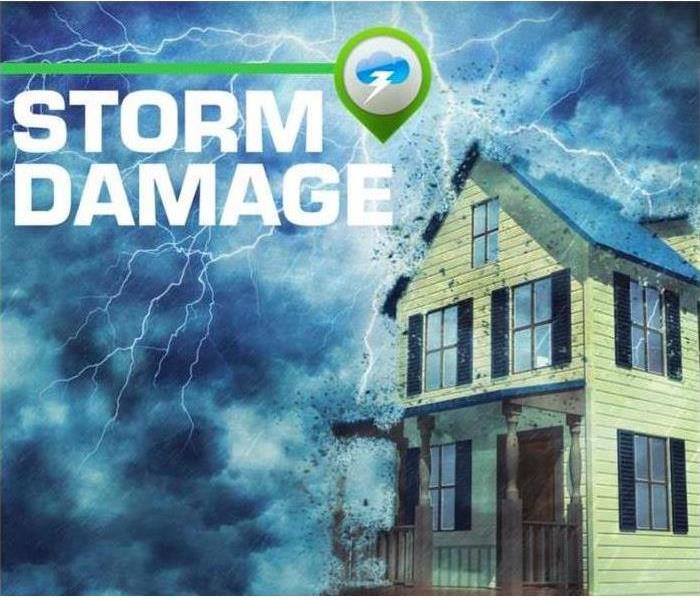 When a storm affects your home or business, call us 636-467-5444.
When a storm affects your home or business, call us 636-467-5444.
SERVPRO Storm Response
Our team here at SERVPRO of Southern and Central Jefferson County is ready for whatever happens, no matter the time of day. Our crews are always on standby. When it comes to fire and water damage, our professionals work tirelessly to make sure our customers are satisfied and are explained each step of the cleaning process.
Highly Trained Storm Damage Specialists
As leading professionals in the storm and water damage industry, we have advanced training and expertise, along with a tremendous amount of hands-on experience. We use this training and experience to quickly dry your home or business and restore it back to pre-storm condition.
Faster to Any Size Disaster
If a storm hits your home or business, odds are you need help immediately. Our quick response will help prevent any secondary damage and help reduce restoration costs.
We Have the Resources to Handle Storms and Disasters
Our team has access to resources and personnel of over 1,800 franchises to handle major storms and disasters. Our team also has access to our exclusive Disaster Recovery Teams strategically located to respond to catastrophic storms and events throughout the country.
Locally Owned and Operated
SERVPRO of Southern and Central Jefferson County is locally owned and operated. We are actively apart of the community with you as well. When you have a storm disaster or flooding emergency, we are in the area and ready to help you.
Lightning Causing House Fires
10/14/2020 (Permalink)
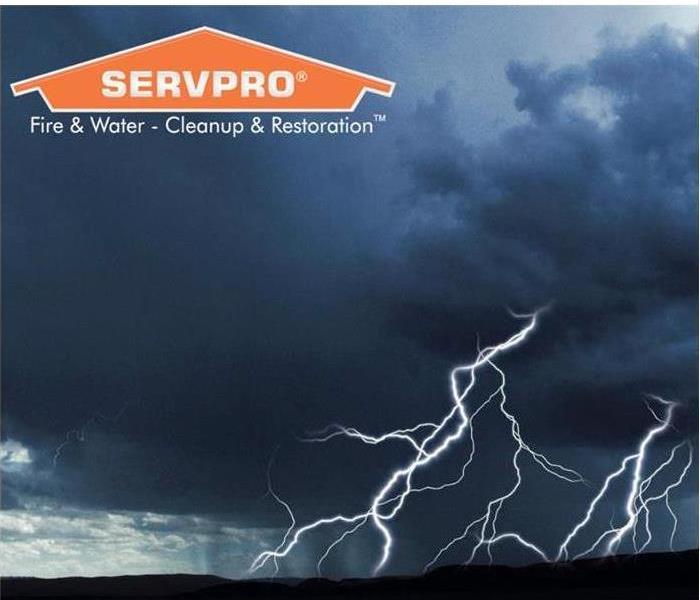 Have no fear, SERVPRO is here!
Have no fear, SERVPRO is here!
According to StormHighway.com:
A cloud-to-ground lightning bolt's main objective is to find the path of least resistance from the cloud to deep into the ground. Most houses are filled with many potential routes for lightning to follow in their journey. This can include gas and water pipes, electric lines, phone lines, cable TV/internet lines, gutters, downspouts, metal window frames - anything conductive in a house is 'fair game' for the lightning to follow.
Lightning passing through a house will often 'branch' and utilize more than one path to ground at a time. It can also jump through the air from one conductive path to another in what is called a side flash. For example, lightning may first connect to electric lines in the attic of a house, then jump to better-grounded water pipes on the first or second floor. Lightning can connect to gutters, then jump to a window frame as a 'stepping stone' to the electrical system or water pipes. All or part of bolts have been seen jumping from wall outlets to sink faucets and even across rooms!
The biggest danger lightning poses to a house is fire. Wood and other flammable building materials can easily be ignited anywhere an exposed lightning channel comes in contact with. It is most common for lightning to start a fire in the attic or roof of a house, as the channel usually has to pass through some of the structural material in the roof before it can reach a more conductive path such as wiring or pipes. When lightning current travels through wires, it will commonly burn them up - presenting a fire ignition hazard anywhere along the affected circuits.
SERVPRO of Southern and Central Jefferson County helps with water and fire remediation. Give us a call at 636-467-5444.
SERVPRO: Here for You 24/7
8/18/2020 (Permalink)
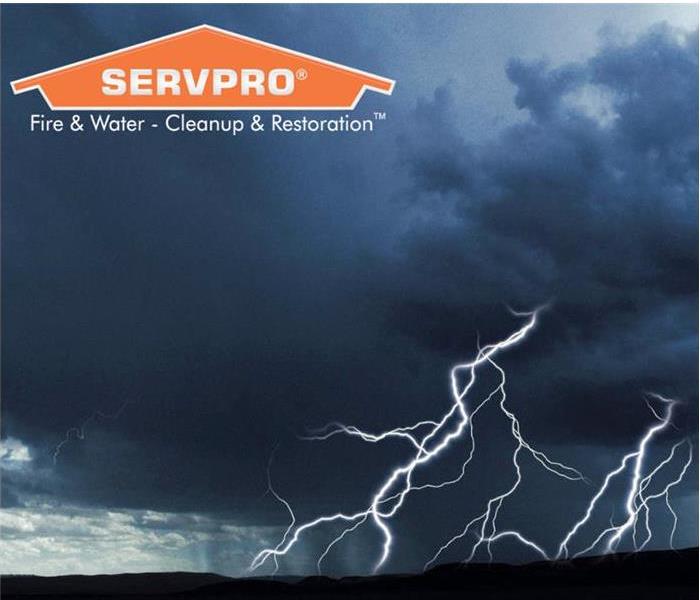 Call us for all your storm damage needs!
Call us for all your storm damage needs!
With our community in mind, SERVPRO of Southern and Central Jefferson County provides emergency service and is dedicated to being faster to any-sized disaster. SERVPRO of Southern and Central Jefferson County is here for you, 24/7. We can respond immediately to your emergency and have the expertise to handle your restoration or cleaning needs.
The extreme Missouri weather conditions can cause a mountain of storm damage. If you are caught in an emergency situation caused by a storm, call SERVPRO of Southern and Central Jefferson County.
We always respond to your call within 1 hour, begin the remediation process within 4 hours, and notify the adjuster no later than 8 hours from the time of your loss. Remember, the longer you wait, the worse the problem will get.
More reasons to choose SERVPRO:
- 24-Hour Emergency Service
- Faster to Any-Sized Disaster
- Highly Trained Restoration Technicians
- A Trusted Leader in the Restoration Industry
- Locally Owned and Operated
- Advanced Restoration and Cleaning Equipment
Have Questions? Call Us Today – (636) 467-5444
Lightning Causing House Fires
8/18/2020 (Permalink)
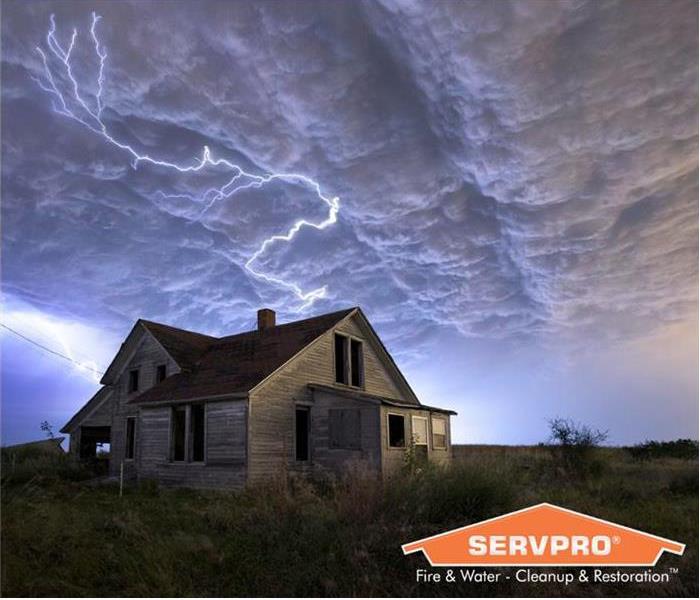 Have no fear, SERVPRO is here!
Have no fear, SERVPRO is here!
According to StormHighway.com:
A cloud-to-ground lightning bolt's main objective is to find the path of least resistance from the cloud to deep into the ground. Most houses are filled with many potential routes for lightning to follow in their journey. This can include gas and water pipes, electric lines, phone lines, cable TV/internet lines, gutters, downspouts, metal window frames - anything conductive in a house is 'fair game' for the lightning to follow.
Lightning passing through a house will often 'branch' and utilize more than one path to ground at a time. It can also jump through the air from one conductive path to another in what is called a side flash. For example, lightning may first connect to electric lines in the attic of a house, then jump to better-grounded water pipes on the first or second floor. Lightning can connect to gutters, then jump to a window frame as a 'stepping stone' to the electrical system or water pipes. All or part of bolts have been seen jumping from wall outlets to sink faucets and even across rooms!
The biggest danger lightning poses to a house is fire. Wood and other flammable building materials can easily be ignited anywhere an exposed lightning channel comes in contact with. It is most common for lightning to start a fire in the attic or roof of a house, as the channel usually has to pass through some of the structural material in the roof before it can reach a more conductive path such as wiring or pipes. When lightning current travels through wires, it will commonly burn them up - presenting a fire ignition hazard anywhere along the affected circuits.
SERVPRO of Southern and Central Jefferson County helps with water and fire remediation. Give us a call at 636-467-5444.
The Impact of Severe Storms
8/18/2020 (Permalink)
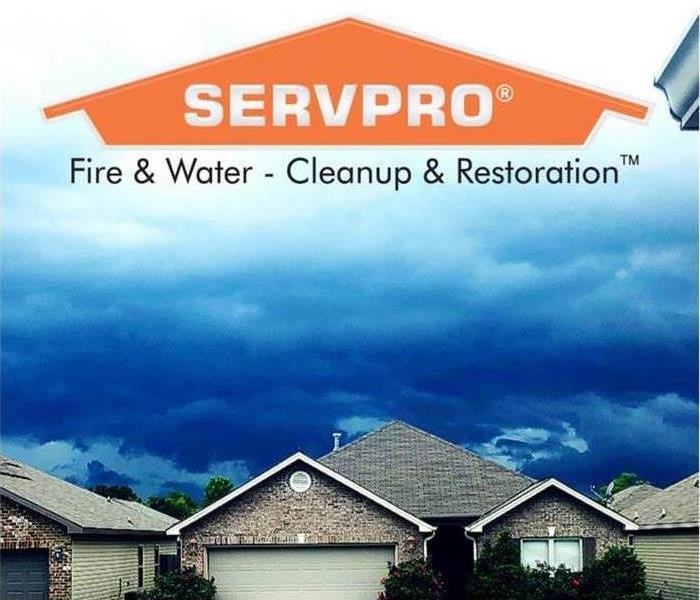 Call us 636-467-5444.
Call us 636-467-5444.
Expecting a tornado or other major storm? There are several steps you can take to stay safe. After the tornado passes, SERVPRO of Southern and Central Jefferson County can help you clean up storm damage and restore your home.
Look for Storm Warning Signs
Tornadoes typically occur when there is a severe thunderstorm in the area. Rain, hailstorms, and lightning strikes are some of the signs of a possible tornado. Some other warning signs of an oncoming tornado include:
- Rumbling or Roaring Sounds in the Air
- Orange or Green Skies
- Rotation of the Clouds
- Very Calm Conditions after a Storm
- Damaged Power Lines or Debris
Staying Informed During a Storm
Local television and radio stations are your best source for updates on how the storm is developing. However, if you hear a tornado siren, you should immediately head to the nearest shelter.
What is the difference between a Tornado Watch, Warning, and Emergency?
- A Tornado Watch means that a storm could be coming in your area soon because of the current weather conditions.
- A Tornado Warning is a sign that one or more tornadoes are in the immediate area. Look for shelter as soon as you see this signal.
- A Tornado Emergency is the final step in the warning process. A tornado has been spotted near a populated location. Move to the safest possible place if you cannot get to a real shelter in time.
Locally Owned Company with National Storm Resources
SERVPRO of Southern and Central Jefferson County is independently owned and operated and we are part of this community, too! When you have a flooding or storm emergency, we’re already nearby and ready to help. We take pride in being a part of the Jefferson County community and want to do our part in making it the best it can be!
Storm Damage? No problem!
7/15/2020 (Permalink)
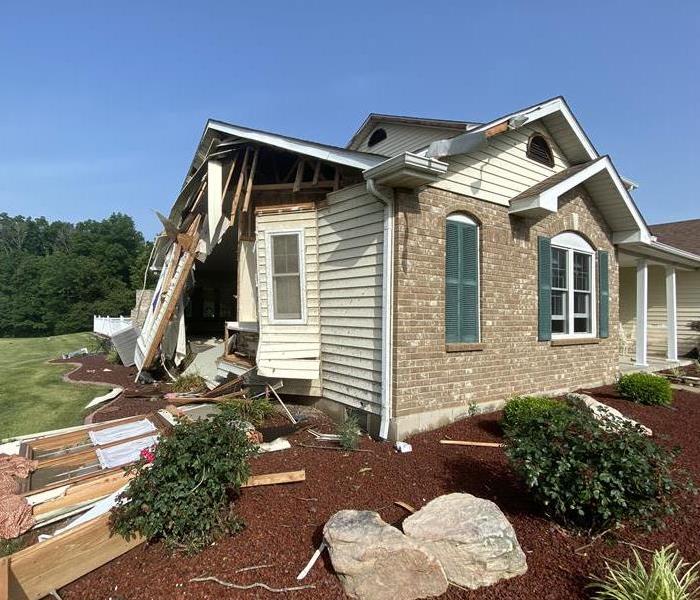 No storm damage is too big or small. Call us anytime.
No storm damage is too big or small. Call us anytime.
When your business suffers serious damage after storm events, SERVPRO of Southern and Central Jefferson County will work around the clock to clean up any debris and to restore the property to preloss conditions. We understand that commercial storm damage can be very costly in terms of productivity; that is why it is always our goal to get your business back up and running as quickly and as seamlessly as possible.
We have the resources to handle large storm damage.
When a storm hits your area, we can scale our resources to handle large-loss commercial restoration projects. We have access to equipment and personnel from a network of over 1,600 franchises across the country, as well as elite Disaster Recovery Teams that are strategically located throughout.
If your home or business is ever damaged by severe floods or storms, call us right away. Disaster can strike when we least expect it, but we will be there to help you weather the storm.
Flooding in Missouri
8/19/2019 (Permalink)
Safety Tips During the Restoration Process
When you live in Missouri, flood safety can be very important for yourself, your family and your home. Both before and after the storm. When the rain is gone, you may find that some clean up and repairs are necessary on your property. Here are a few safety tips you may want to follow during the restoration process.
- Proceed Safely
Proceed as safely as possible when assessing any flood damage to your home. This means not entering any unsafe areas and taking the appropriate safety steps before beginning work.
- Turn Electricity Off
Always turn the electricity off to any flooded area before entering. Doing so can help you prevent any number of safety hazards.
- Wear Protective Gear
Another important step for flood safety is the use of proper protective gear. This may include coveralls, masks, gloves, and boots or shoe covers. Any items worn in the flooded area should also be washed in hot water to help avoid contaminating the rest of the home.
- Contact a Professional
When possible it's best to contact a water damage restoration service to conduct repairs on your home. These experts will know what is best to be done to get your residence back in livable condition as quickly as possible.
- Sanitize Everything
Sanitation is an important step the restoration process. This will help ensure that no bacteria remain on any object touched by the flood water, and that nothing is brought back into the home after restoration is complete.
When it comes to your home and family flood safety is important both before and after the storm. Following these tips may help. Remember to turn electricity off and wear protective gear in any area you are working. It may be best to contact a professional to handle the repairs. You may also want to be sure that everything is properly sanitized.
Winter Weather: Get Prepared Now!
8/19/2019 (Permalink)
The change in season will be here before you know it. It requires a few items homeowners can check to help get ready. Check to make sure hoses are disconnected from exterior faucets, even if they are frost-free faucets. Leaving a hose connected increases the possibility of a frozen hose bib, which can rupture inside the exterior wall of your business or home and cause flooding.
Make sure the thermostat is set to an appropriate temperature if you’re planning on being away from home over the holidays. Open cabinet doors for cabinets that have plumbing, especially on exterior walls to make sure the temperature stays above freezing. Have a professional check and service your furnace for proper operation and signs of potential failure.
If you are planning on being away from home for an extended period, it is a good idea to have a plumber winterize the plumbing system. If winterizing isn’t possible, turning off the water main can be a good way to ensure that if a problem does arise, it doesn’t cause too much damage before it is located.
If the unfortunate does happen, be sure to give us a call here at SERVPRO of Southern and Central Jefferson County at 636-467-5444. We have highly trained technicians and top of line drying technology to help restore your home or business after a flood. Call us today to see what we can do for you!
SERVPRO + Storm Damage
8/19/2019 (Permalink)
SERVPRO of Southern and Central Jefferson County specializes in storm and flood damage restoration. Our crews are highly trained, and we use specialized equipment to restore your property to its pre-storm condition.
Faster Response Guaranteed!
Since we are locally owned and operated, we can respond quicker with the right resources, which is extremely important. A fast response lessens the damage, limits further damage, and reduces the restoration cost.
Resources to Handle Floods and Storms
When storms hit our servicing areas, we can scale our resources to handle a large storm or flooding disaster. We can access equipment and personnel from a network of 1,750 Franchises across the country and elite Disaster Recovery Teams that are strategically located throughout the United States.
Have Storm or Flood Damage? Call Us Today 636-467-5444. We are faster to any size disaster.
Flash Flooding
7/15/2019 (Permalink)
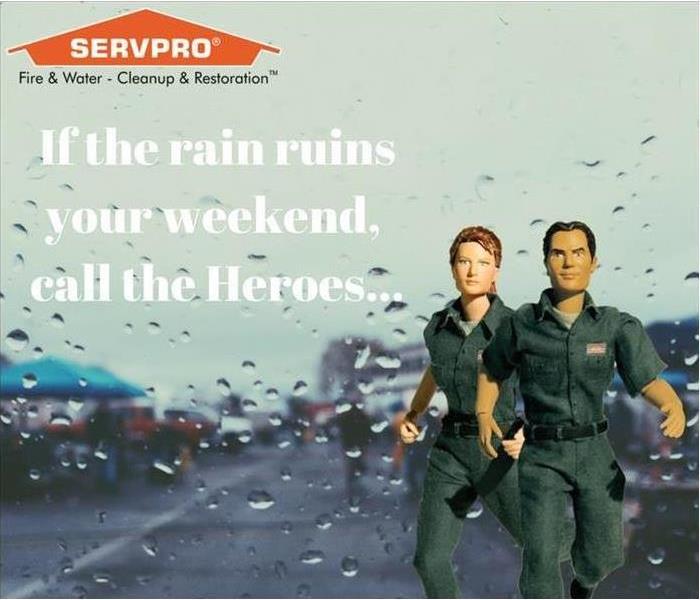 If the rain ruins your weekend, Call the heroes of Southern and Central Jefferson County (636)467-5444
If the rain ruins your weekend, Call the heroes of Southern and Central Jefferson County (636)467-5444
We are currently experiencing another round of storms that are predicted to last for a couple days during this summer. Flash flooding has been predicted in the area as well. Our area is still in the process of recovering from flood waters that lasted nearly two months. SERVPRO of Southern and Central Jefferson County wants to remind everyone to keep a watchful eye out on the weather and flood waters. Flash flooding can happen very quickly especially in areas where water already exceeds its normal limit. We encourage you to not approach or attempt to drive through flooded roadways as they are extremely hard to properly judge the amount of water covering the roadway. We also want you to know we are here if you experience any type of flooding event. Our technicians are prepared to deploy 24 hours a day 7 days a week to handle any of your flooding needs.
When winter weather strikes, we strike back!
7/19/2018 (Permalink)
Winter weather will be here before we know it!
Prepare your home!
- Keep cabinet doors open during cold spells. This allows warm air to circulate around pipes.
- Keep a slow trickle of water flowing through faucets, especially if the pipes for faucets run through unheated or uninsulated areas of your home.
- Consider shutting off outdoor faucets. Find the shut-off valve in the basement or crawl space and turn it to “off .”
- If you follow the previous step, then open the outdoor faucet to help ensure it drains completely and the inner valve is shut off.
- Ensure gutters are clean and secure. Leaves and debris accumulate, causing a damming effect on gutters, which could lead to roof problems and water damage.
- Proper maintenance of your furnace can help reduce the risk of puffbacks.
Frozen Pipes
A frozen pipe can burst at the point where the ice blockage inside the pipe is located, but typically the rupture is caused by the backflow pressure between the water source and the blockage. A burst pipe can cause considerable damage to your property if not addressed quickly. SERVPRO of Southern and Central Jefferson County is faster to any size disaster, bringing the latest equipment and training to help make your water damage “Like it never even happened.”
Ice Dams
Ice dams can be a major problem during the winter season. They form when heated air melts roof snow downward into water dammed behind still-frozen ice. When the trapped water cannot safely flow or run into the gutter system, it can backflow under the roof’s shingles and into the structure’s interior areas. SERVPRO can help mitigate water damage caused by ice dams and help you get your structure back to preloss condition.
Puffbacks
A puff back is a messy furnace malfunction that occurs when an oil burner backfires, sending soot throughout your home or business. It can happen all at once, covering an interior in grimy soot, or a puff back can leak soot particles more gradually. Equipped with the training, tools and experience to quickly and efficiently clean and restore your home or business, SERVPRO will help make your puff back “Like it never even happened.”
Storm Damage
7/18/2018 (Permalink)
Watch vs. Warning
A severe thunderstorm watch means that the potential exists for the development of thunderstorms which may produce large hail or damaging winds. A watch is issued by the SPC (Storm Prediction Center).
A severe thunderstorm warning means that a severe thunderstorm is occurring or is imminent based on Doppler radar information or a reliable spotter report. A warning is issued by the local National Weather Service office.
_______________________________________
Watch vs. Warning and Storm Basics are provided by NOAA (National Oceanic and Atmospheric Administration). For more information visit their website: www.noaa.gov
Storm Basics
A thunderstorm is a rain shower which you hear thunder. Since thunder comes from lightning, all thunderstorms have lightning.
A thunderstorm is classified as "severe" when it contains one or more of the following:
- Hail (One inch or greater)
- Winds in excess of 58 mph
- Structural wind damage
- Tornado
Tornado Facts
Tornadoes are arguably nature’s most violent storms. Generated from powerful thunderstorms, tornadoes generally appear as rotating, funnel-shaped clouds extending from the cloud base to the ground. With winds that can reach up to 300 miles per hour, tornadoes can cause massive destruction within seconds. Damage paths can be in excess of one mile wide and fifty miles long.
- The average tornado moves southwest to northeast, but tornadoes have been known to move in any direction.
- The average forward speed of a tornado is 30 miles per hour, but may vary from stationary to 70 miles per hour.
- Tornadoes can accompany tropical storms and hurricanes as they move onto land.
- Tornadoes are most frequently reported east of the Rocky Mountains during spring and summer months.
- Tornadoes are most likely to occur between 3 p.m. and 9 p.m.
Before the Storm
- To begin preparing, you should build an emergency supply kit and make a family communication plan.
- Remove dead or rotting trees and branches that could fall and cause injury or damage during a severe thunderstorm.
- Postpone outdoor activities. n Remember the 30/30 Lightning Safety Rule: Go indoors if, after seeing lightning, you cannot count to 30 before hearing thunder. Stay indoors for 30 minutes after hearing the last clap of thunder.
- Secure outdoor objects that could blow away or cause damage.
- Get inside a home, building, or hard top automobile (not a convertible). Although you may be injured if lightning strikes your car, you are much safer inside a vehicle than outside.
- Remember, rubber-soled shoes and rubber tires provide NO protection from lightning. However, the steel frame of a hard-topped vehicle provides increased protection if you are not touching metal.
- Shutter windows and secure outside doors. If shutters are not available, close window blinds, shades or curtains.
- Unplug any electronic equipment well before the storm arrives.
During the Storm
- Use your battery-operated NOAA Weather Radio for updates from local officials.
- Avoid contact with corded phones. Use a corded telephone only for emergencies. Cordless and cellular telephones are safe to use.
- Avoid contact with electrical equipment or cords. Unplug appliances and other electrical items such as computers and turn off air conditioners. Power surges from lightning can cause serious damage.
- Avoid contact with plumbing. Do not wash your hands, do not take a shower, do not wash dishes, and do not do laundry. Plumbing and bathroom fixtures can conduct electricity.
- Stay away from windows and doors, and stay off porches.
- Do not lie on concrete floors and do not lean against concrete walls.
- Avoid natural lightning rods such as a tall, isolated tree in an open area.
- Avoid hilltops, open fields, the beach or a boat on the water.
- Take shelter in a sturdy building. Avoid isolated sheds or other small structures in open areas.
- Avoid contact with anything metal—tractors, farm equipment, motorcycles, golf carts, golf clubs, and bicycles.
- If you are driving, try to safely exit the roadway and park. Stay in the vehicle and turn on the emergency flashers until the heavy rain ends. Avoid touching metal or other surfaces that conduct electricity in and outside the vehicle.
After the Storm
- Never drive through a flooded roadway.
- Stay away from storm-damaged areas to keep from putting yourself at risk from the effects of severe thunderstorms.
- Continue to listen to a NOAA Weather Radio or to local radio and television stations for updated information or instructions, as access to roads or some parts of the community may be blocked.
- Help people who may require special assistance, such as infants, children and the elderly or those with access or functional needs.
- Stay away from downed power lines and report them immediately. n Watch your animals closely. Keep them under your direct control.
- If you have storm damage to your home or property, call SERVPRO of Farmington. Timely mitigation is key to minimize secondary damages caused by severe storms.
SERVPRO of Southern and Central Jefferson County Services
Unexpected emergencies like severe weather call for immediate action. SERVPRO of Southern and Central Jefferson County knows immediate reaction to the disaster is important to helping you get your life back to normal.
Utilizing our 1-4-8 Service Response Guidelines*, SERVPRO of Southern and Central Jefferson County strives to:
- Contact you within 1 hour from notice of loss to arrange for service.
- Be on-site to begin mitigation services within 4 hours of notification.
- Provide verbal briefing of scope to you within 8 business hours of on-site arrival.
SERVPRO of Southern and Central Jefferson County can also perform pack-out services, which is removing salvageable personal property from the affected area for off-site cleaning and storage.
_______________________________________
*Exceptions may apply under certain conditions, such as a local catastrophic event or storm situation.
Tips For Working With Your Insurance
7/18/2018 (Permalink)
Regular life is stressful enough, but if you are surprised with flooding or other water damage in your home, everyone in the household will be stressed. Whether flood damage leaves carpeting soaked and soggy or you have come back to a disaster after evacuation, severe weather and damaged pipes will cause significant worry about how to start putting back together your daily life.
However, you can prepare for these unknowns by knowing what to expect and create a plan in case of emergency. To assist you, SERVPRO of Southern and Central Jefferson County has put together this mini-guide to help you understand the flood insurance claim process.
The first thing you will want to do is call your insurance provider. Although the U.S. government funds the National Flood Insurance Program (NFIP), local home and rental insurance companies are the exclusive sellers of Flood Damage Insurance. While you will be working directly with an insurance agent, SERVPRO can also serve as a liaison, helping you to navigate through the claims process.
After your initial call to your insurance company, contact your SERVPRO of Southern and Central Jefferson County at 636-467-5444. We are available every day, all day, to handle your emergencies. Even if you are not able to reach your insurance agent immediately, SERVPRO will take your call and begin to work with you on first response remediation solutions. Have questions about what to do first or what items can be restored? SERVPRO is here to answer those questions and more! Our compassionate team understands your distress and will guide you through the storm damage restoration process.
Now you can begin your water damage restoration. We pride ourselves on having the fastest response time to storm damage in your area. We will arrive at your home prepared to conduct an inspection and moisture readings, create a scope of the damage and provide an estimate for you and your insurance provider. Our team will arrive prepared and ready to start immediately. We can store and access your information easily and quickly.
Our SERVPRO team members are the premier flood and water damage restoration experts in Farmington and surrounding areas. We are also the preferred remediation team for home insurance providers, and the most trusted helper for storm disasters. Storm damage restoration and navigating flood insurance claims can feel stressful, but we are here to assist you with every stage of the recovery process.
For emergencies and other situations, call 636-467-5444 anytime to reach your area flood damage experts, SERVPRO of Southern and Central Jefferson County. We help residential and commercial property owners when natural disasters, water damage, sewer backups, floods, mold infestations, fires and other events happen.
Storm Damage- Like it never even happened.
Storm Damage- Like it never even happened.
7/13/2018 (Permalink)
When mother nature is at her absolute worst, SERVPRO of Southern and Central Jefferson County is at its best! Immediate response, expert assessment and specialized equipment are paramount in the aftermath of a severe storm or wind damage. As with any of our core services, SERVPRO of Southern and Central Jefferson County takes extra special care in salvaging and restoring any property that may have been affected.
Severe weather never sleeps and neither do we! SERVPRO of Southern and Central Jefferson County is always a mere phone call away when disaster strikes. Our Storm Response Team travels nationally to any area devastated by natural disaster. Give us a call at 636-467-5444 or check out our other storm blogs! Our crews will make it "Like it never even happened."
Do you have storm damage? Call us today at 636-467-5444.
Keep Your Pets Safe!
7/12/2018 (Permalink)
This information was developed by the U.S. Department of Homeland Security in consultation with: American Kennel Club, The American Society for the Prevention of Cruelty to Animals, American Veterinary Medical Association, and The Humane Society of the U.S, and SERVPRO.
If you are like millions of animal owners nation wide, your pet is an important member of your household. The likelihood that you and your animals will survive an emergency such as fire or flood, tornado, or terrorist attack depends largely on emergency planning done today. Some of the things you can do to prepare for the unexpected, such as assembling an animal emergency supply kit and developing a pet care buddy system, are the same for emergency. Whether you decide to stay put in an emergency or evaluate to a safer location, you will need to make plans in advance for your pets. Keep in mind that what's best for you is typically what's best for your animals.
If you must evacuate, take your pets with you if possible. However, if you are going to a public shelter, it is important to understand that animals may not be allowed inside. Plan in advance for shelter alternatives that will work for both you and your pets.
Make a back-up emergency plan in case you can't care for your animals yourself. Develop a buddy system with neighbors, friends, and relatives to make sure that someone is available to care for or evacuate your pets if you are unable to do so. Be prepared to improvise and use what you have on hand to make it on your own for at least three days, maybe longer. Preparing for the unexpected makes sense. Get ready now.
1. Prepare: Get a Pet Emergency Supply Kit
Just as you do with your family's emergency supply kit,think first about the basics for survival, particularly food and water. Consider two kits. In one, put everything you and your pets will need to stay where you are. The other should be a lightweight, smaller version you can take with you if you and your pets have to get away. Plus, be sure to review your kits regularly to ensure that their contents, especially foods and medicines, are fresh.
Food. Keep at least three days of food in an airtight, waterproof container.
Water. Store at least three days of water specifically for your pets in addition to water you need for yourself and your family. Medicines and medical records. Keep an extra supply of medicines your pet takes on a regular basis in a waterproof container.
First aid kit. Talk to your veterinarian about what is most appropriate for your pet's emergency medical needs. Most kits should include cotton bandage rolls, bandage tape and scissors; antibiotic ointment; flea and tick prevention; latex gloves, isopropyl alcohol and saline solution. Include a pet first aid reference book.
Collar with 10 tag, harness or leash. Your pet should wear a collar with its rabies tag and identification at all times. Include a backup leash, collar and 10 tag in your pet's emergency supply kit. In addition, place copies of your pet's registration information, adoption papers, vaccination documents and medical records in a clean plastic bag or waterproof container and also add them to your kit. You should also consider talking with your veterinarian about permanent identification such as microchipping, and enrolling your pet in a recovery database.
Crate or other pet carrier. If you need to evacuate in an emergency situation take your pets and animals with you provided that it is practical to do so. In many cases, your ability to do so will be aided by having a sturdy, safe, comfortable crate or carrier ready for transporting your pet. The carrier should be large enough for your pet to stand, turn around and lie down. Sanitation. Include pet litter and litter box if appropriate, newspapers, paper towels, plastic trash bags and household chlorine bleach to provide for your pet's sanitation needs. You can use bleach as a disinfectant (dilute nine parts water to one part bleach), or in an emergency you can also use it to purify water. Use 16 drops of regular household liquid bleach per gallon of water. Do not use scented or color safe bleaches, or those with added cleaners.
A picture of you and your pet together. If you become separated from your pet during an emergency, a picture of you and your pet together will help you document ownership and allow others to assist you in identifying your pet. Include detailed information about species, breed, age, sex, color and distinguishing characteristics.
Familiar items. Put favorite toys, treats or bedding in your kit. Familiar items can help reduce stress for your pet.
2. Plan What You Will Do in an Emergency
Be prepared to assess the situation. Use whatever you have on hand to take care of yourself and ensure your pet's safety during an emergency. Depending on your circumstances and the nature of the emergency the first important decision is whether you stay put or get away. You should understand and plan for both possibilities. Use common sense and the information you are learning here to determine if there is immediate danger. In any emergency, local authorities mayor may not immediately be able to provide information on what is happening and what you should do. However, watch TV, listen to the radio or check the Internet for instructions. If you're specifically told to evacuate, shelter-in-place or seek medical treatment, do so immediately.
Create a plan to get away. Plan how you will assemble your pets and anticipate where you will go. If you must evacuate, take your pets with you if practical. If you go to a public shelter, keep in mind your animals may not be allowed inside. Secure appropriate lodging in advance depending on the number and type of animals in your care. Consider family or friends willing to take in you and your pets in an emergency. Other options may include: a hotel or motel that takes pets or a boarding facility, such as a kennel or veterinary hosp ital that is near an evacuation facility or your family 's meeting place. Find out before an emergency happens if any of these facilities in your area might be viable options for you and your pets.
Develop a buddy system. Plan with neighbors, friends or relatives to make sure that someone is available to care for or evacuate your pets if you are unable to do so. Talk with your pet care buddy about your evacuation plans and show them where you keep your pet's emergency supply kit. Also designate specific locations , one in your immediate neighborhood and another farther away, where you will meet in an emergency.
Talk to your pet's veterinarian about emergency planning. Discuss the types of things that you should include in your pet's emergency first aid kit. Get the names of vets or veterinary hospitals in other cities where you might need to seek temporary shelter. You should _---","! A also consider talking with your veterinarian about permanent identification such as microchipping, and enrolling your pet in a recovery database. If your pet is microchipped, keeping your emergency contact information up to date and listed with a reliable recovery database is essential to your being reunited with your pet.
Gather contact information for emergency animal treatment. Make a list of contact information and addresses of area animal control agencies including the Humane Society or SPCA, and emergency veterinary hospitals. Keep one copy of these phone numbers with you and one in your pet's emergency supply kit. Obtain "Pets Inside" stickers and place them on you r doors or windows, including information on the number and types of pets in your home to alert firefighters and rescue workers. Consider putting a phone number on the sticker where you could be reached in an emergency. And , if time permits , remember to write the words "Evacuated with Pets" across the stickers, should you flee with your pets.
3. Stay Informed Know About Types of Emergencies
Some of the things you can do to prepare for the unexpected, such as assembling an emergency supply kit for yourself, your family and your pets , is the same regardless of the type of emergency. However, it's important to stay informed about what might happen and know what types of emergencies are likely to affect your region as well as emergency plans that have been established by your state and local government. For more information about how to prepare , visit www.ready.gov or call 1-800-BE-READY. Be prepared to adapt this information to your personal circumstances and make every effort to follow instructions received from authorities on the scene. With these simple preparations, you can be ready for the unexpected. Those who take the time to prepare themselves and their pets will likely encounter less difficulty, stress and worry. Take the time now to get yourself and your pet ready.
Hurricane Assistance
7/12/2018 (Permalink)
Although Missouri doesn't have hurricanes, SERVPRO of Southern and Central Jefferson County has assisted SERVPRO franchises on the East Coast to help with hurricane aftermath.
Storm Response
When the storm is a major event, you need more comprehensive restoration support. SERVPRO is “Ready for whatever happens.”
Time is Money
As the leader in water damage restoration, SERVPRO® knows fast mitigation is the key to limiting business interruption. With an unmatched national footprint of over 1,500 Franchises nationwide, SERVPRO® is faster to any size disaster and can be on-site within a few hours to help reduce the future damage water can cause. We have the right equipment, procedures and training to help ensure the structure is dry the first time, saving you time and money.
Storm Teams
SERVPRO has mobilization teams across the country to travel as needed to support large storm events. Need 1,000 crews for a month? Only SERVPRO can make it happen!



 24/7 Emergency Service
24/7 Emergency Service












